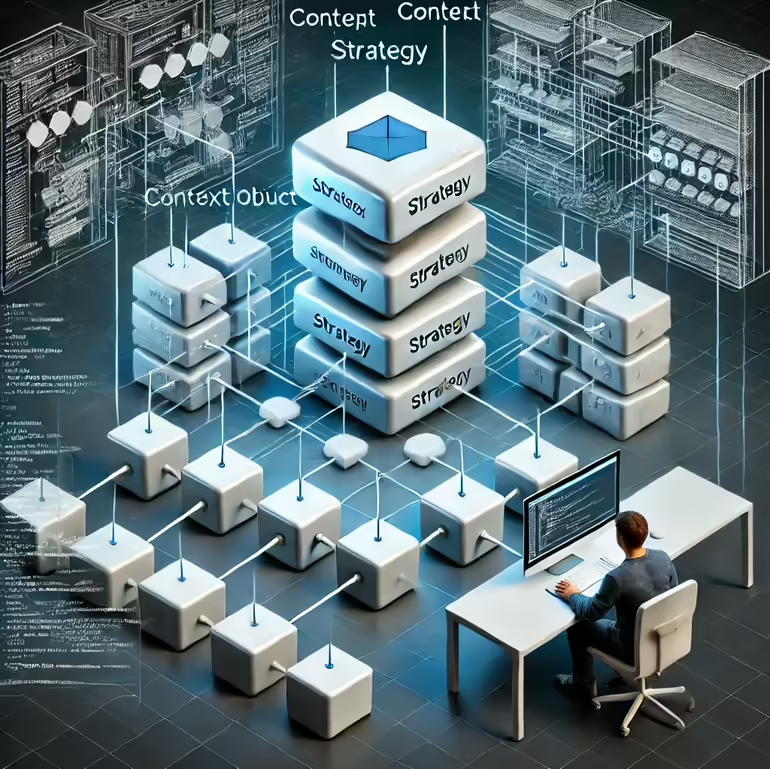In today’s fast-paced digital landscape, the need for flexible, maintainable, and scalable software solutions is greater than ever. Whether you’re a candidate looking to advance your career in software development or a hiring leader searching for specialized talent to tackle complex system designs, understanding key software patterns is essential. One such pattern that stands out for its ability to simplify complexity is the State Pattern, a behavioral design pattern that allows an object to change its behavior when its internal state changes.
In this blog, we’ll explore the concept of the State pattern, its components, benefits, and use cases, while also diving into how Curate Consulting Services can assist both businesses and job seekers in leveraging this pattern to drive innovation and efficiency.
What is the State Pattern?
At its core, the State pattern enables objects to alter their behavior based on their internal state, modeling their behavior as a finite set of states and transitions. Instead of cluttering a single object with conditional logic for every possible state, the State pattern cleanly separates each state into distinct classes. This promotes code that is both clean and maintainable, making it a go-to choice for developers working on systems that require dynamic behavior.
Here’s a high-level breakdown of the components of the State pattern:
Context: This is the main object whose behavior changes depending on its internal state. It maintains a reference to the current state object and delegates behavior to the relevant state class.
State: An interface or abstract class that defines the actions or methods for all concrete states.
Concrete State: Each concrete state class implements the state interface or extends the abstract class. These classes represent the specific behaviors associated with a particular state of the context object.
Example: Traffic Lights System
Consider the simple yet familiar example of a traffic light. Traffic lights operate in a sequence: Red → Green → Yellow. In this scenario, the Context would be the traffic light system itself, while each color (Red, Green, Yellow) would be represented by a Concrete State class. Each state encapsulates the specific behavior associated with that light color, ensuring clean and logical transitions between states.
This design makes the system highly maintainable, as adding new states (such as a flashing yellow) would not require modifying the entire traffic light logic, but only adding a new Concrete State class.
Benefits of the State Pattern
The State pattern provides several advantages that make it a strong choice for software design in many industries. Let’s explore these benefits:
1. Clean Separation of Concerns
By delegating state-specific behaviors to separate classes, the State pattern cleanly separates concerns. This reduces the complexity of the main object (the Context) and adheres to the Single Responsibility Principle, a key tenet of software engineering. Each Concrete State class only manages the logic relevant to its specific state, making the system easier to understand and maintain.
2. Flexibility for Extensibility
One of the standout advantages of the State pattern is its flexibility. New states can be added without modifying existing code. This extensibility makes it particularly valuable for evolving systems, where new features or behaviors may need to be introduced over time without disrupting current functionality.
3. Ease of Maintenance
Code maintenance becomes more streamlined with the State pattern. Since each state’s logic is encapsulated within its corresponding state class, developers can easily locate, modify, or debug the behavior of a particular state without wading through tangled code in the main object.
4. Controlled State Transitions
State transitions in the State pattern are controlled and managed consistently. Instead of relying on multiple conditional statements to dictate behavior, the pattern uses well-defined transitions between Concrete State classes, leading to more predictable and reliable software behavior.
Real-World Use Cases of the State Pattern
The State pattern is widely used across different industries, particularly in systems where objects change behavior depending on their state. Let’s look at some common use cases:
1. Vending Machines
A vending machine is an excellent example of the State pattern. The machine’s behavior changes depending on its state (waiting for money, dispensing a product, giving change, etc.). The State pattern allows the machine to handle these transitions smoothly without excessive conditional logic.
2. Traffic Light Systems
As discussed earlier, traffic light systems utilize the State pattern to manage transitions between different states (red, yellow, green). The pattern ensures that the light operates logically, shifting between states with defined transitions.
3. Workflow Automation
State machines, a concept closely related to the State pattern, are often used in workflow automation systems. These systems transition through various states based on events or user inputs, with the State pattern offering a structured way to manage those transitions.
4. Game Development
In gaming, characters or game objects often need to change behavior based on their state (e.g., attacking, defending, idle). The State pattern allows for easy management of these behaviors and their transitions, making game development more modular and maintainable.
How Curate Partners Can Help
As your business grows, so does the complexity of your software systems. Implementing advanced design patterns like the State pattern requires skilled talent that understands the intricacies of software architecture. This is where Curate Consulting Services comes in.
We specialize in finding highly specialized talent in areas such as software development, IT infrastructure, and digital transformation. Our team works closely with businesses to understand their specific challenges and staffing needs, ensuring that we find the right candidates with the right skills. Whether you’re looking for a developer with expertise in the State pattern or a consultant to optimize your software architecture, Curate Partners can help.
Tailored Staffing Solutions for Businesses
At Curate Partners, we don’t just provide staffing solutions—we deliver tailored consulting services that align with your business goals. If you’re looking to adopt the State pattern or any other advanced software design methodologies, we can connect you with top-tier talent who understand the technology and how to apply it in real-world scenarios.
Empowering Candidates to Excel
For candidates, understanding the State pattern is a valuable skill that sets you apart in the competitive software development job market. Whether you’re a seasoned developer or just starting your career, mastering the State pattern can help you take on more complex and rewarding projects. Curate Partners is dedicated to helping professionals like you find opportunities that match your skills and career aspirations.
Conclusion
The State pattern is a powerful tool for building flexible, maintainable, and scalable software systems. It separates state-specific behaviors into individual classes, making code easier to manage and maintain. From vending machines to traffic light systems, the State pattern has proven its worth in a variety of real-world applications.

